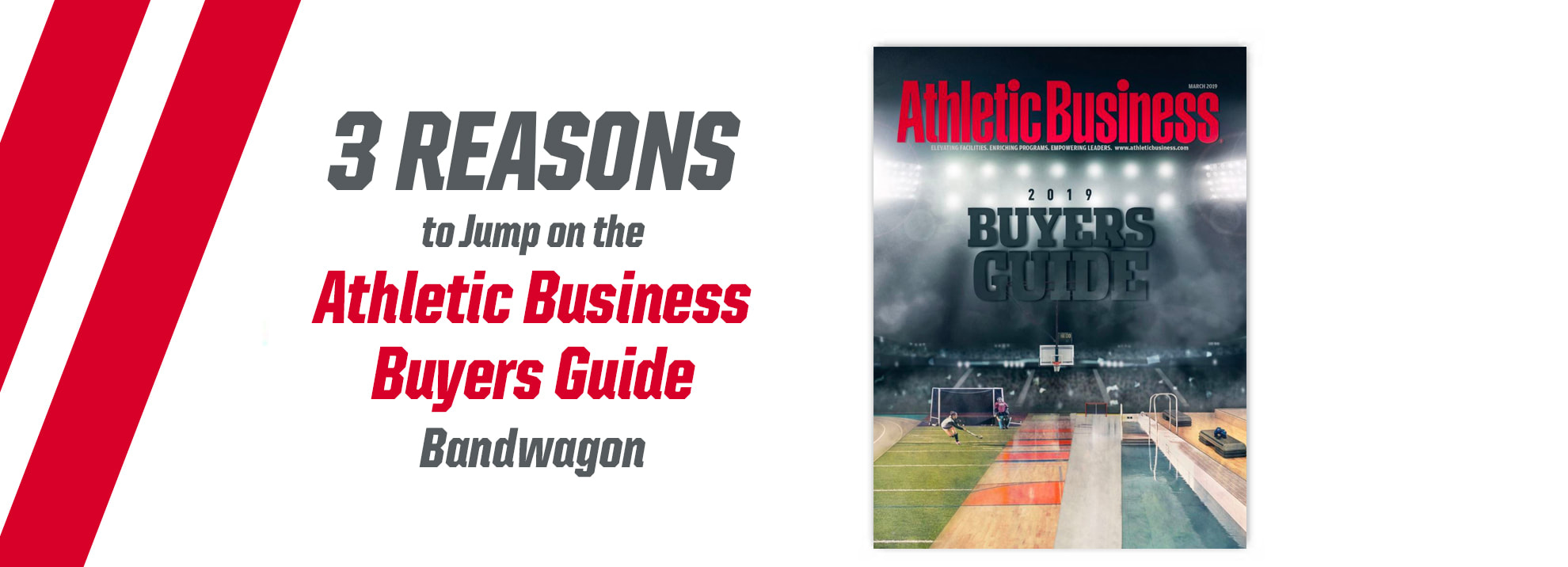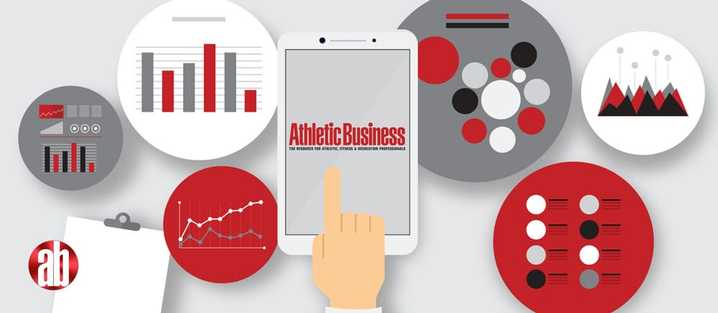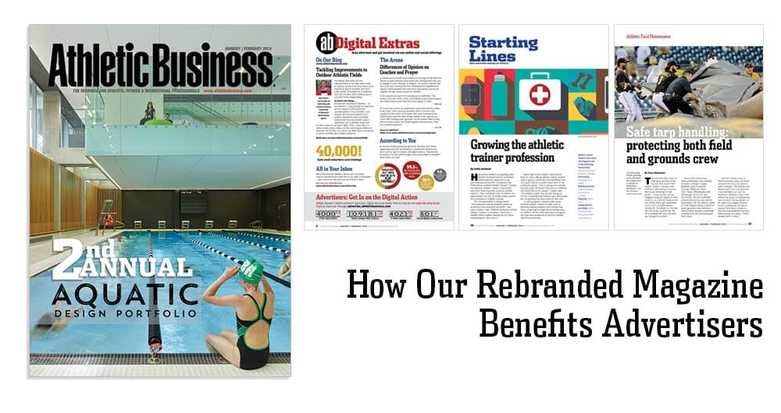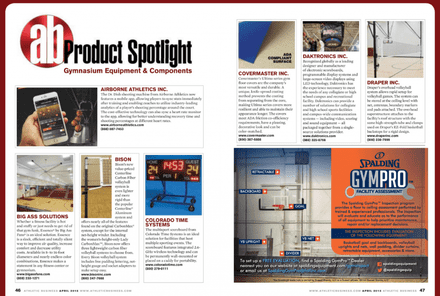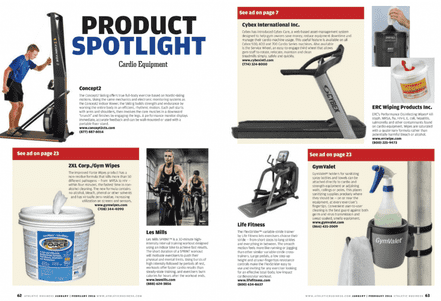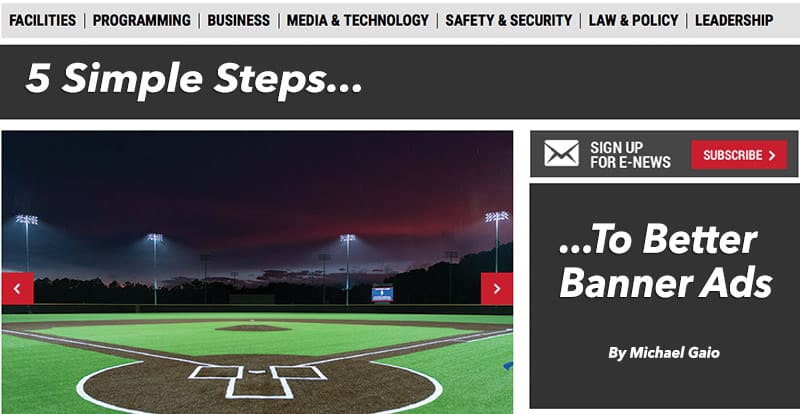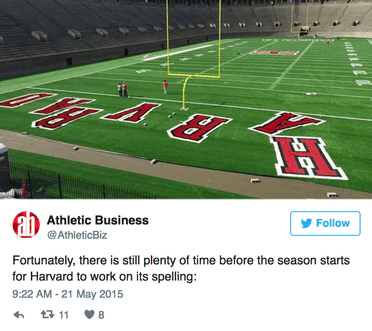|
More and more customers are taking advantage of our Custom E-Mail solution. With Athletic Business, you don't need to compromise between quality and quantity — we have both!
After working with hundreds of customers to send successful Custom E-Mails (and our own marketing emails) over the years, we want to share our top five tips to make your email get traction with our subscriber base of athletics, fitness and recreation decision-makers! 1. Subject Line, Subject Line, Subject Line! This is your first impression and can make or break your success (the best email in the world won’t do any good if no one opens it). We’ve found that the best subject lines offer value to the recipient, rather than just a sales message. In fact, the most successful subject lines rarely include brand or product names. Additionally, subject lines that indicate a video or include “Why” or “How” prove to perform well. Finally, research shows around 41 characters is the optimal length for a subject line, so keep it concise. Here are some examples of ways you can transform your subject line to fit these best practices:
2. Determine Your Purpose and Audience Everyone has a different reason for sending a Custom E-Mail — from launching a new product to driving web traffic and everything in between. Knowing exactly what your want your prospects to do will help you craft the right message and call-to-action to achieve your goals. The most successful emails have a single, clear call-to-action, and messaging that garners enough interest to take that desired action. Also consider taking advantage of our targeting capabilities. With a segmented list, you know the exact prospects you’ll be reaching and can tailor your message to have the most impact. 3. Use of Engaging Media As alluded to in our first tip, videos and other interactive media drive click-throughs better than anything else. Emails with a prominently displayed video will encourage the opener to click-through to view it. It is most beneficial to link to the video embedded on your website to gain valuable web traffic, rather than linking to view on a video hosting platform, such as YouTube. Other engaging media options include whitepapers, infographics, photo galleries or customizable “build your own product” interfaces. If your goal is to drive clicks, enticing the recipient with content-rich media is a good way to do so. 4. Consider the Length It can be tempting to put your entire sales message into the body of your marketing email; however, using your messaging as a teaser is a best practice we recommend to all customers. With the "teaser" method of messaging, your customers will be more likely to click-through to your website to learn more about your product or brand. Keeping your message concise is especially important when you consider that roughly half of all email users will be on a mobile device, where multiple scrolls to the bottom of an email can be detrimental to success. 5. Think About Your Landing Page You’ve piqued the curiosity of your prospect with a great subject line, you gave them just enough information to leave them wanting more, and your call-to-action inspired them to click-through. Now what? Your landing page should be consistent with your email. If there is a disconnect between what you promised in your email and what customers find on your landing page, they're likely to leave your site right away. Furthermore, making the investment to have a mobile-friendly site can go a long way for those users who opened your email and click-through to your site on their cellphone (remember, this is about half of all email users). Other tips or suggestions would be to have a singular focus on your page, just as your email did, and to utilize forms or other means of capturing visitor contact information. These are just a few tips to help you make the most of your Custom E-Mail. Of course, every business has different objectives and circumstances, and we'd love to work with you on an email campaign that will help you meet your goals.
0 Comments
Our highly anticipated Athletic Business Buyers Guide is the most comprehensive directory in the athletics, fitness and recreation industry. Providing the most accurate, up-to-date company listings and product/service updates is important to us, and our 40,000 audited print subscribers and 1 million+ online visitors. It’s the main reason why the AB Buyers Guide is the industry-leading resource that keeps our readers coming back. Here are the top 3 reasons why companies advertise in the AB Buyers Guide year after year and why you might consider jumping on the bandwagon: 1) Your prospects actually use it Don’t just take our word for it – according to our most recent audit statement, 87% of our circulation directly requested to receive Athletic Business. The best part? Our print subscribers are verified athletics, fitness and recreation decision-makers, meaning these decision-makers are ready to find your products and services for their programs and facilities. 2) Year-long, high-quality visibility in print and online Get ready for the crucial leads you’ve been looking for with our 40,000 print subscribers and 1 million+ annual website visitors – all getting the chance to see your product or service! You’ll also receive bonus distribution at major industry trade shows including NIRSA, IHRSA, NACDA, NRPA, AB Show, NFHS and AOAP. So, it’s safe to say your brand and product/service offerings won’t go unnoticed. 3) You’ll stand out amongst competitors Your prospects are here, help them find you faster and easier. As subscribers search the AB Buyers Guide, both online and in print, advertisers are more likely to be found for heightened brand awareness with boldface listings in print and priority search results online. Talk about getting ahead of the competition and setting yourself apart. Take advantage of a reduced rate when you upgrade to an expanded online profile to gain even more exposure. Hopefully these three advantages speak loudly to what we provide our advertisers at Athletic Business. Interested in helping your brand reach quality buyers with the 2020 Athletic Business Buyers Guide? Jump on the bandwagon before it's too late! Let's chat and come up with a strategic marketing plan today. Ad close: January 28, 2020
There was a lot of excitement around the Athletic Business and NIRSA partnership announced in early 2018. You may have seen the press release or noticed the signage at the NIRSA Conference, recognizing AB as the Preferred Media Partner of NIRSA. And while this is big news for the college recreation industry, you might be wondering how it benefits you as an advertising partner with Athletic Business. Here are three ways the AB + NIRSA partnership will benefit our advertising partners:
Are you ready to take advantage of the AB + NIRSA partnership? Contact:
With 40 years of industry experience, we understand the type of content that has a direct impact on the daily lives of the athletic, fitness and recreation professional. Why is this important you might ask? For this simple reason: CONTENT IS KING! The 40,000 readers of Athletic Business magazine and our tens of thousands of online visitors each month (your prospects) choose to engage with content that is meaningful and impactful to their daily lives – and we have the stats to prove it. In an era of 24/7 connectivity to email, social media and general “marketing noise”, brands, more than ever, need to ensure their marketing initiatives are being seen and recognized where their audience is and WHEN they are consuming engaging content. This is when true marketing magic happens and when your brand connects in a much more personal way with your target market. Content that provides a real value to readers creates a relationship and brand loyalty. This drives traffic online and via social media platforms and keeps readers there longer. But a website with very little content or connection to its visitors will receive limited pageviews, higher bounce rates, less engagement and few return visitors, limiting the exposure of any advertising on that site or publication. When evaluating your marketing spend, make sure audience engagement is at the top of your list. Without it, you might be advertising—in print or online—to an empty room. Interested in learning more about marketing opportunities with Athletic Business? Let’s chat!
There are many marketing options out there, and it can be overwhelming to sift through the information and determine the best fit for your company. There are several key factors to consider that will help you compare apples to apples and identify the most appropriate and effective marketing vehicle for your company and the outcome you are looking to achieve.
2) Evaluate The Target Data and List Integrity It’s important that your media partner is able to prove that your message is reaching the intended audience. To ensure you’re connecting with your best prospects, you must evaluate the integrity of the audience you are paying to reach. Some important questions to ask:
3) Seek Proven Statistics One of the wonderful things about digital advertising is that it is trackable. By asking the questions outlined above, you will have a good idea what to expect going into a campaign. If a media partner is unable to provide you with proven average statistics over a period of time, that should be a red flag. A reputable media partner will often partner with a third party to track the analytics of your campaign and should provide a stat report on a regular basis. Want to learn more about how Athletic Business can help with your marketing needs? Contact:
There’s a new trend in advertising sweeping the nation. And as the author of this marketing blog I feel compelled to tell you more about it.
This advertising medium is driving web traffic, helping brands separate themselves from competitors and leaving an impact on niche audiences from athletics to antiques. So what is it? It’s print. That’s right, trusty print advertising is the “New ‘New Media’” according to the Columbia Journalism Review. “Print is beautiful,” author Chava Gourarie writes in this piece published on CJR’s website. She continues: It can’t notify you when a work email arrives, can’t be tweeted mid-sentence, and won’t die without a charger. Even better, it’s finite. It’s also supposed to be dead. For years, the new media vanguard has preached “digital first” and the death knell has sounded again and again for print, as legendary magazines moved online or ceased publication altogether. Now, 20 years into the digital revolution, print is making something of a comeback. In fact, 2015 saw the launch of 204 new print magazines according to Samir Husni, a University of Mississippi professor known online as “Mr. Magazine.” As a media company that prides itself on creating a quality print product, this article underscores a trend we have seen at Athletic Business as well. Many clients I work with are surprised to learn print advertising is the most popular form of advertising among our customers. Gourarie has a great theory for why that is. Magazines, especially those with niche audiences (such as B2B magazines), foster tight niche communities that are appealing to subscribers and advertisers. “People want to be part of a tribe, and magazines with tailored content for an ardent readership reinforce a strong sense of community,” Gourarie writes. The importance of print advertising is just one of the reasons we recently invested in rebranding our magazine. A magazine is “like a membership card you receive once a week, or month,” says Husni. This sentiment is backed up by Athletic Business’ own subscribers, 94 percent of whom are involved in purchasing decisions for their organization. “I feel like I’m a member of Athletic Business,” Diane Dahlmann, University of Missouri’s Student Recreation Complex Director, said in a focus group at the Athletic Business Show. “Yes, it’s a service and it’s a trade show and it’s a magazine, but most of all it’s a community.” And as an advertiser, the print magazine gives you a unique opportunity to connect with that community in a setting where the reader is not distracted by the chime of a new email or the next “to do” popping up on their computer. Of course, integrated marketing remains important. Digital advertising can help you reach tens of thousands of prospects in addition to those who receive the magazine. But the next time you’re looking do something special with your marketing budget, take a hard look at print advertising. Your prospects are doing the same. The athletic, fitness and recreation industry as a whole seems to be getting stronger each year as we bounce back from the Great Recession. And that was no exception for us at AB in 2015. Thanks to our loyal audience and advertising partners, we enjoyed another strong year in all forms of media. In today’s blog we share a quick breakdown of some of our statistics from 2015 and more important, why they matter to you.
Website:
E-News:
Social:
Print:
We wanted to share these numbers with you not to pat ourselves on the back, but to show that AB is continuing to find ways to connect with highly qualified industry professionals wherever they are choosing to engage. With our audience growing and getting more digitally savvy each year, it’s important that our advertising partners know we’re right there, connecting you with our audience on any platform, any time. You might have noticed something different about the last issue of Athletic Business when it arrived on your desk. Over the past six months we’ve been working on a rebranding. Everything from the magazine’s cover to the content inside has been given a facelift. “Using some lingo from the industry, think of the rebranded magazine like a rec center that just received a major renovation,” says Ron Reason, a nationally renowned design consultant who advised AB on the redesign. “We’ve made it easier for people to find their way in, find what they’re looking for, keep them engaged while they’re there and keep them coming back.” But as an advertiser, you might be asking yourself, “so what?” How does our rebranded magazine benefit you? We answer that question in today’s blog post. 1. Backed by Data While our staff felt it was time to freshen up the magazine, the most important thing was finding out what our readers thought. So we asked them. The results of our reader survey were very positive. More than 76% of survey respondents said they “never miss an issue” of Athletic Business. But they still had suggestions for ways we could improve. They asked for more visual content so we hired an art director, Nicole Bell, and devoted more resources to illustrations, infographics and photography. We are also adding several new content sections and we’ll outline those in point number three below. We didn’t just make a change just to make it. We did it to better serve our readers and our advertisers. As an advertiser, knowing our readers will be spending more time with the magazine means greater exposure for your message. 2. A Better Vehicle for Your Brand Our magazine is the biggest reflection of our brand. While other brands cut back on their magazine, AB invested in making ours better. “There is so much talk about digital, digital, digital,” says Reason. “But print is still the most important aspect of your brand. AB clearly understands that and committed to creating the best product possible for readers and advertisers.” When you partner with AB, you are aligning yourself with our brand. That’s not something we take lightly. We always strive to present our magazine — and your advertising message — in the best way possible. The clean, fresh look of the rebranded magazine helps us do that better than ever. 3. More Content As mentioned earlier, the rebranding brings an array of new content. This helps us (and our advertisers) build an even stronger connection with our subscribers. Our readers said they wanted more content devoted to leadership and career improvement so we’ve added a “Personal Best” column written by leaders in our industry. They asked for more articles on safety and security so we enlisted the help of the experts at the NCS4 to bring readers more content devoted to that topic. We devoted more space to new product sections so readers are aware of the latest and greatest products on the market. “We knew we didn’t need to make drastic changes, but the additional content we’re now providing will make the magazine even better,” says AB editor Emily Attwood. 4. More Engaging, Easier to Read, Yields Bigger Audience AB has always been known for editorial excellence, but now that editorial content is easier to find, easier to navigate and more inviting than ever. “What sets AB apart is the content we provide our readers,” says Bell who oversees the magazine’s layout. “Keeping that in mind, the information people receive today is very visual. The goal was to find that perfect balance. Inviting readers in with the best information they trust us to provide, and hopefully having them stay for a while with beautiful photographs and graphics.” Making the magazine more engaging means readers will spend more time with it. They will be more likely to share it with their coworkers and colleagues. And this means more value for your advertising. 5. A Better Advertising Landscape
Finally, there are some subtle changes that might go unnoticed if you’re not a design expert. The magazine has more white space and images no longer “bleed” off the page, helping your advertisements stand out. Fonts have been updated. There are more sidebars and visuals throughout the magazine. “What I really love about this redesign is how clean the layout looks,” Bell says. “If a message is being conveyed through an image or through type, a clean layout allows that idea to come through.” We hope you enjoy the rebranding and reap the benefits of an improved advertising landscape. You can see the changes for yourself in our January/February issue which should be arriving soon if it hasn’t already. Don’t receive our magazine? Contact Diane or Michael to be added to our advertiser comp list. If you’re reading this blog, you’ve likely been to a few (or for some of you, a few hundred) trade shows. You know the routine. You spend weeks, maybe even months preparing for the show: It finally arrives, it’s exciting, you’re meeting tons of people, gathering leads and then in a matter of days it’s over. When you get back to the office, how do you make sure you capitalize on your interactions with the prospects you’ve just met? Companies spend a lot of time and money preparing for and attending shows. However, the greatest returns only happen when you take action afterward. In an earlier blog post we addressed tips for maximizing your trade show investment before a show. In the wake of our own trade show — the Athletic Business Conference & Expo (check out the time lapse video below) — we wanted to discuss some tips for maximizing your show investment once you return home. 1. Categorize Your Leads
Not everyone you met at the show requires the same action and urgency. Some prospects that you met might be ready to buy and will require a phone call ASAP, while others are better candidates for e-mail campaigns or follow-ups further down the line. But just because someone isn’t a “hot” lead doesn’t mean they should be ignored. Categorize your leads into hot, medium and cool groups (or whatever lingo you want to use) and then determine which follow-up methods are right for which group. 2. Prompt Response Now this might be a bit late if you were an ABC exhibitor, but it’s important to keep in mind for any trade show you attend: the sooner you can respond to your prospects, the better. According to a 2012 study by the Center for Exhibition Industry Research, less than 50% of exhibitors send an e-mail to their leads within a week of the show. With every day that passes, the likelihood of your lead forgetting your interaction, losing interest or getting too busy back in the office increases. Make it a priority to follow up as quickly as possible. 3. Personal Response When possible, a personal response whether by phone, e-mail or both is proven to be more effective than mass communications. Now, not every single lead will require a personal follow-up, but for your most important ones, it is worth the time. In the same study referenced above, its conclusion states: Customizing follow-up e-mail communications, tailored to attendees, who they are and what they articulated interest in, makes sense. It demonstrates to the attendee that an exhibitor was listening. It motivates an attendee to pay attention. In today’s marketing environment where consumers demand personal attention, targeted communications are a must. And that was three years ago! The same truths are more apparent today. 4. Call to Action When you follow-up with your leads, particularly via e-mail, give them a clear call to action. Of course, the end goal is to purchase your product, but for high-dollar items like many in this industry, that may take some time. In the meantime, maybe your goal is to get them to sign up for your newsletter, have them follow you on social media, or download a whitepaper you’ve produced. All of these actions build your connection with the prospect and give you another way to reach them. Whatever your company’s goal may be, give the prospect a clear and easy way to take the action you desire. Bombarding them with too many options can backfire. 5. Content! Speaking of whitepapers, adding value to your follow-up communication by providing additional content can be a great way to nurture leads. You had a great conversation about a particular product? Send the prospects a link or maybe a video with more information. Someone expressed a particular problem they needed to solve at their facility? Send them your blog post on that exact subject. Of course to do this, you need to have a method of remembering the discussions you had with specific show attendees. Some companies do this electronically by adding notes when they scan badges. If you’re the old-school type, jotting a few notes on the back of a business card can help. Is there something we’re missing? Feel free to share your tips in the comments below. Or tell us in person at the next industry trade show. *The photo used in this blog post was taken by Brian Ebner, Optic Nerve. With the new year approaching, now is the time to create a marketing plan and start measuring your success.
It’s a simple question, yet one that can be so difficult to answer: “What do you hope to achieve?” Anytime someone is considering advertising with Athletic Business, that question is one of the first things we ask. The response serves as the jumping off point for our conversation. It helps our team guide you to the right media mix for your brand. The scary thing is, oftentimes the customer doesn’t have an answer. Whether it’s brand recognition, more website traffic, becoming a thought leader in the industry, lead generation or all of the above, most customers haven’t considered their end goal. Nearly everyone we work with knows that advertising helps their company. They know that reaching AB’s niche audience can help drive sales. But as for the specifics? Many haven’t gotten that far. And that’s what I wanted to address in this post. Below are four recommendations to help you get started on a successful marketing plan for 2016: 1. Creating a Marketing Plan Helps You Maximize Your Investment As Ben Franklin once said, “By failing to prepare, you are preparing to fail.” That’s not to say a marketing plan automatically guarantees success. But having a plan will help you stay organized. It will make your workflow more efficient. It will allow you to target key dates, maximize special promotions and boost your exposure at trade shows. And best of all, it can help you maximize your investment and track the ROI. If you go into the year with a set plan and a set budget, you can find the right advertising resources to make the most of it. 2. Outline Goals and Create a Plan Around Those Goals Is your company looking for more awareness in the market? Are you looking to grow market share? Boost sales of a particular product? Improve the perception of your brand? Become a thought leader in the industry? Different companies have different objectives. Any marketing plan should lay out your goals and a road map to achieve them. Knowing what you’re trying to accomplish will help you narrow down your advertising options and find the solutions that are right for you. 3. Integrated Marketing is the Best Approach It’s important to remember that different prospects engage with different forms of media. Digital marketing receives a lot of buzz and at Athletic Business we’re working hard on some advanced technology to make your digital advertising more effective. Yet, there is a large segment of our audience that only reads the print magazine. In fact, 93% of professionals surveyed in a recent study by Martin Akel and Associates said that print publications are still a “desirable way” to access information. Additionally, a 2015 readership survey completed by Readex Research found that 82% of respondents choose trade publications and websites as their top way of staying informed on industry products and services. If you’ve ever clicked around this site, you’ve probably come across the Venn Diagram shown here. It shows how different portions of our audience engage with us in different ways. Whether your advertising plans include AB or not, we recommend using an integrated approach — making your brand visible online, in print and in person at industry trade shows — to ensure you reach the entire market and not just those who choose to consume one form of media. 4. Determine How Success Will Be Measured Perhaps the most important part of your marketing plan will be measuring its performance. How you judge performance will vary depending on your marketing goals and the product mix in your plan. Common measurables for our advertising partners include number of impressions their ads receive, traffic to their website, growth in social media following, or open rates and click-throughs on custom e-mails. We can help you test different types of messaging and determine what is most successful for your brand. With a new year just around the corner, it’s important to start thinking about your plan for 2016. Our team is happy to speak with you about your specific objectives and help determine the best path forward. In the meantime, happy planning! A trade show is a big investment. However, there is nothing like talking to prospects face-to-face and seeing them try out your products or services in person. Whether it’s the upcoming Athletic Business Conference & Expo, or any of the other shows in our industry, here a few tips to help you make the most of your trade show investment before you ever arrive on-site or set up your booth.
1. Get the Word Out It may seem obvious, but it’s important to spread the word out about your presence at the show. Use your own marketing channels — social media, email, maybe direct mail — to let your customers know you’ll be at the show and what products you’ll have on display. Of course, you’ll want to reach people who aren’t in your existing network. We’ve seen first-hand with some of our partners how advertising in trade magazines — or the multimedia services they offer — before the show pays dividends come show time. Trade media is a great way to get people excited about your presence at an upcoming show. 2. Tap Into the Show’s Marketing Efforts Read up on the show you’ll be attending. If there is a free or discounted pass for trade show only attendees, it might be worth passing that information on to your customers. Some shows also offer incentives to exhibitors who bring additional attendees to the show. 3. Seek out Social Media Take advantage of the show’s social media efforts. Use the show’s official hashtag (ABC’s this year is #ABCnola) to get your message in front of attendees. At ABC, we often retweet and share messages from our exhibitors, helping them spread the word about their presence at the show. 4. Think About Your Booth Is your booth drawing people in or is it set up in a way that’s keeping people out? Tables set up on the outside of a booth can act as a barrier. Try moving them inside your booth to draw people in. Also consider removing chairs from your booth. When standing, you’re much more likely to approach people who pass by and spend less time staring at your phone. Finally, make sure your signage is easy to read and makes the casual attendee want to learn more about what you offer. These are all things to consider before you arrive at the show. 5. Create a Dedicated Web Page Attendees at the show are going to seek you out online. Is your website ready for them? Creating a dedicated page for the specific trade show can help you communicate a cohesive message between your presence at the show and your content online. 6. Add a Personal Touch In tip no. 1 we mentioned getting the word out. Mass communications like email, social media and direct mail can be very effective. However, for some of your top customers — especially ones in the region of the show — reaching out with a personal invitation may be worth the extra effort. 7. Sponsorship Opportunities Give your presence an extra boost by sponsoring one of the events or special aspects of the show. It will require an extra investment, but the additional exposure can help you stand out from your competitors and drive traffic to your booth. After putting on the Athletic Business Conference & Expo 34 times, these are just a few tips we’ve seen over the years that have proven to be effective. Hopefully they’ll work for you, whether that’s at our show in November or any of the other shows in this industry. It’s no secret that marketing departments have shrunk over the years. If you’re at a large company, it’s likely you handle what was once the work of two or three people. If you’re at a small company, you might be your company’s entire “marketing department”—all while manning two or three other jobs. It’s enough to make you freak out sometimes. The good news: all that responsibility means every day is a new challenge. The bad news: it can get overwhelming. Below are seven tips to help you manage your time a little more efficiently and keep yourself less stressed. 1. Learn to Say No It’s just two letters, but sometimes ‘no’ is the toughest word in our language. Just because you can do something doesn’t always mean you should. Spreading yourself too thin causes all of your work to suffer. It’s important to be a helpful and cooperative coworker, but sometimes being honest with someone upfront is better than telling them ‘yes’ only to fail to deliver later. 2. Shut Down Your Inbox It’s so easy to become beholden to your inbox. The key is managing your time, not letting your inbox manage your time. Set a block of time where you log out of email, put your phone out of sight (and on silent) and focus on the work you need to get done without the interruption of email. 3. Find Natural Transition Points Wasting 10 minutes here or there can really add up. A common source of lost time is transitioning between tasks. It can be difficult to get one project out of your mind and immediately devote 100 percent of your attention to something new. To combat this, try to find natural transition points like meetings or lunch. Finish one task before these events. Then, when you return to your desk you can focus on what’s next with a clear head. 4. Plan for Interruptions So you’ve been procrastinating. Your project is almost due so you think, “Today I’ll just focus on this project for four straight hours and get it done.” Of course, things don’t work out that way. Even if you could focus on something for four straight hours you’re bound to be interrupted. People stopping by your desk, phone calls, emails (see #2), impromptu meetings. All of those interruptions can really stress you out if they’re disrupting what you “should” be doing. Keep that in mind when planning your day. You’re going to get interrupted. Things are going to take longer than expected. 5. Plan Ahead Speaking of planning… It’s so simple, but even the slightest bit of preparation goes a long way. As Ben Franklin once said, “By failing to prepare, you are preparing to fail.” Before heading home at the end of the day, take a look at your calendar and jot down some notes or at least mentally prepare yourself for the following day(s). Nothing worse than showing up to work and having a meeting that you forgot about. 6. Set Goals, Mini Goals From the time we’re kids we’re told to set goals. But goals are worthless if they’re not reasonable. Set mini, realistic goals for your day. For example, when I have two client videos to finish, writing down “Finish videos” is overwhelming since each one takes several hours. But if I write down, “Upload footage and write script before lunch,” I suddenly have a reasonable goal that I’m motivated to complete. Plus, when you’ve achieved that day’s goals you know you can head home satisfied with your day’s work. 7. Eat the Frog Mark Twain famously said, “Eat a live frog first thing in the morning and nothing worse will happen to you the rest of the day.” Apply this mentality to your to-do list. Get your most unpleasant task out of the way first and your day will only get better from there.
Hopefully one or two of these suggestions help make your professional life a little less stressful. And less stress is important important. According to Harvard researcher, New York Times best selling author (and keynote speaker at the 2015 Athletic Business Conference & Expo) , Shawn Achor, a positive mindset is the biggest factor in professional success. Achor says 75 percent of our professional success is predicated not by intelligence, but by our optimism, social support network and the ability to manage energy and stress in a positive way. Something to consider next time you’re ready to freak out. The trusty website advertisement is a mainstay in many of our customers’ marketing packages. With more than a million people visiting athleticbusiness.com each year, a banner ad — whether it’s the leaderboard or a block ad — can be an efficient way to gain exposure among buyers in athletics, fitness and recreation. Over the years, we’ve seen hundreds of different banner ads on our website and learned that the most effective ones have several things in common.
Here are five simple steps to an effective website banner ad: 1. Keep it Simple You only have so much real estate to work with in this space. This is not the space to list off every feature and benefit of your new product. Let your website do that. The ad should simply entice the prospect to take your desired action. Choose one clear message or focal point of your ad. A solid background with a clear message and/or graphic is best. Clutter is your enemy in this space. 2. Mimic Your Website Design When a prospect clicks through to your website, make it clear immediately that they have ended up where they intended — the banner design should have the same color scheme and branding as the landing page. Consistency is the key. 3. Include a Call to Action Some customers use banner ads as nothing more than a digital billboard. They simply want exposure for their brand to keep it on the minds of prospects. However, if you’re seeking click-throughs, adding a button or text with a specific prompt has been proven to increase the click-through rate. For example: “Sign Up Today.” “Click Here to See the Video.” “Click Here to Download.” If the goal is clicks, a call to action should be included. 4. Consider an Incentive Along the lines of including a call to action, is including an incentive. A special promotion for prospects that is available only through the banner campaign. This allows you to direct sales by offering a unique promo code or phrase, specifically for those prospects who saw your advertisement. 5. Test! Test! Test! The great thing about digital advertising is the detailed reporting that comes along with it. We can tell you just how effective your ad is. Take advantage of the data by testing different ads to see which ones work best. Run an A and B banner consecutively and monitor which one garnered more clicks. You might be surprised at the results, and this can help guide the design for your future digital marketing materials. Of course, every marketing campaign is different. Depending on what your goals and objectives are, our team can work with you to make sure they’re achieved. As I’ve come to learn, there is no shortage of big personalities in our industry. From the serious to the hilarious, our advertising partners (and our readers) run the gamut. And when it comes to social media, there’s nothing wrong with letting that personality shine through. Before getting into marketing, I served as Athletic Business’s social media manager. I would travel to trade shows and people would ask me what tone or “voice” they should be using for their company’s social media accounts. For smaller companies, the answer is simple: your own! If you’re funny in real life, it’s OK to be funny! If you pride yourself on being professional and straight-laced, take that approach. What is your company’s story? What kind of impression are you trying to make? At Athletic Business, we try to keep our posts professional and informative. This one for example, is fairly straightforward. However, occasionally a certain story (like the tweet about Harvard below) allow us to be more playful. In a larger organization, your company may already have its own distinct voice. It’s important that employees managing social media understand the tone their company wants and are comfortable communicating in that tone.
Whatever route you go, make it authentic and keep it consistent. Your social media followers (think, customers or potential customers) will see right through you if you’re trying to be somebody you’re not. And a feed without a consistent voice or “personality” can leave followers confused. Now, not everyone is a comedian. And a Twitter feed full of jokes won’t help you grow your business. But a witty remark or creative photo caption related to your industry can help put a human face on your brand. The same can be said about replying and engaging with your followers. Think of social media as a telephone, a two-way conversation, not a megaphone to blast your message to anyone within shouting distance. This is social media after all. Along with your informative (i.e. not always promotional) posts targeted for your specific audience, a little personality and interaction can go a long way. So next time you’re over-thinking that Facebook post or sweating over your next 140 characters, allow me to be the voice of reason: The only voice you need to worry about is your own. In my first blog I recommended David Meerman Scott’s book, “The New Rules of Sales and Service” and explained how it advocates selling through storytelling.
Many marketers already know this, but they’re making one critical mistake. They think they can tell their story and reach potential buyers on their own. It’s a comment we hear occasionally: “Why would I advertise? We have an email list of customers, a website with great information and a social media following to blast our message to.” Nothing wrong with that. But what about those buyers out there who don’t know you? The buyers who aren’t on your email list, visiting your website or following you on social media? I hate to break it to you, but there are tons of them out there! And many of them are turning to their industry’s trade publications to guide them through buying decisions. But rather than take my word for it, here is some powerful data to consider: In an independent study, media consulting firm Martin Akel & Associates surveyed business professionals across 27 different industries, including athletics and fitness. A few facts from the study that lend credence to the power of trade media:
As I said in my last blog, it’s crucial to be telling your brand’s story and giving potential buyers information. But you can’t go it alone. Trade media is a great way to continue to tell your company’s story and expose that story to thousands of new prospects — prospects with real buying power. There are a million books out there on marketing and sales. Some good, some not-so-good. When I come across one that I find beneficial, I feel compelled to share it with others in marketing.
I recently read David Meerman Scott’s book, "The New Rules of Sales and Service." The Some of you may recognize the author’s name. He also wrote “The New Rules of Marketing and PR,” which was an international bestseller and is now assigned reading at many colleges around the country. “The New Rules of Sales and Service” has become required reading for our sales and marketing staff here at AB. As the book (and Scott himself in the video below) explains, whether you’re in sales or marketing, we’re all in this together. Sales and marketing departments today need to be one cohesive unit, sharing information and working together to zero in on buyers. With that in mind, here are three takeaways from the book: 1. The Rules Have Changed Today, “buyers are in charge of the relationships with companies they choose to do business with,” Scott writes. That’s because today’s buyers have more information at their disposal than ever. They are educating themselves about their buying options before they ever reach out to a specific company to make a purchase. With that in mind, the more information marketers can provide the buyer, the better. Allow the buyer to educate themselves about your products or services on their own time and do business with you on their terms. For example, think about the last time you bought a car. Did you simply drive to a dealership and rely on the salesperson to tell you everything you need to know? Or did you do hours of research online, comparing specs, prices and features, reading articles, browsing magazines and reading reviews? The companies that use their websites, emails, social media and advertising to educate their buyers are the ones finding success. Your sales staff exists to guide the educated buyer over the finish line, putting the finishing touches and recommendations on a sale. But it’s the marketers who need to arm the buyer with solid information first. 2. Know Your Story “Telling your story” is a cliche, but Scott breaks it down matter-of-factly. In marketing materials, you’re not creating copy, you’re telling a story. And that story needs to be true to resonate with buyers. Maybe it’s one of innovation. Or proud tradition. Or excellent customer service. Whatever it is, your story should align with the thinking of your customer. i.e. I’m willing to pay more for a product that is more technologically advanced. Some of the best stories have villain. Maybe your “villain” is the status quo, a misconception among buyers or a certain player in your industry. When telling your story, cut the jargon and buzzwords that customers see right through. People want to be spoken to like a real person. Industry buzzwords, vague claims like “industry leading” or “best-in-class,” only distract the buyer from the information they want. “Your customers aren’t looking to satisfy your ego, and they don’t really care what you think about the stuff you sell,” Scott writes. “Your buyers want to solve their problems.” 3. No More “Making Stuff Up” You can’t market to people you don’t understand. A successful marketer is not just an expert on his or her company’s products and services, but also the company’s buyers. From the book: Organizations filled with people who take the time to understand the needs of buyers they wish to reach, and then develop information to educate and inform those buyers, are more successful than organizations that just make stuff up. The problem? I see it again and again. The way most salespeople, marketers, and product managers operate is by making stuff up… The worst part? In these making-stuff-up sessions, everyone in the room works for the company, and therefore there is no representation of the voice of people who will actually buy the products and services. Get to know your buyers and everything else becomes a lot easier. This blog just scratches the surface on the ideas in the “The New Rules of Sales and Service.” For the rest, you’ll have to read it yourself. From one marketer to another, I highly recommend it. |
CONTACT |
|




